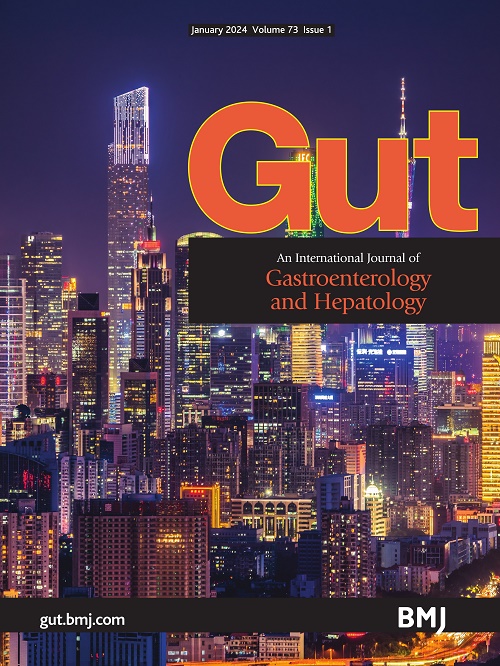膳食乳清蛋白通过协调肠道噬菌体和细菌群之间的跨王国相互作用来预防克罗恩病
IF 23
1区 医学
Q1 GASTROENTEROLOGY & HEPATOLOGY
引用次数: 0
摘要
肠道菌群和饮食是克罗恩病(CD)发病和治疗的重要因素。然而,肠道噬菌体在饮食影响下的作用尚不清楚。目的探讨饮食对肠道噬菌体-细菌相互作用与乳糜泻保护的影响。我们招募了乳糜泻患者和健康受试者(n=140),进行了多组学研究,包括配对回肠黏膜噬菌体和细菌组分析、饮食调查和表型组调查。我们筛选了饮食对肠道噬菌体和细菌群的影响,以及其与乳糜泻风险的流行病学关联。通过靶噬菌体-细菌体外单培养和共培养以及两种小鼠体内模型探讨了其潜在机制。在人类饮食筛选中,发现乳清蛋白(WP)的摄入对肠道噬菌体和细菌组(对噬菌体的影响更明显)有深远的影响,并与较低的乳糜泻风险相关。事实上,WP重塑的肠道噬菌体可以减轻肠道炎症,从食用WP和不食用WP的小鼠到受体小鼠的粪便噬菌体和细菌组移植表明了这一点。在机制上,WP诱导噬菌体(本文新分离的噬菌体AkkZT003P)裂解嗜粘蛋白细菌Akkermansia muciniphila,释放共生细菌嗜热链球菌来对抗肠道炎症。结论我们的研究揭示了肠道噬菌体和细菌之间的跨界相互作用在调节饮食对乳糜泻保护作用中的重要性。重要的是,我们发现了一种有益的膳食WP,一种关键噬菌体AkkZT003P和一种益生菌S. thermoophilus,可用于未来的乳糜泻管理。无数据。本文章由计算机程序翻译,如有差异,请以英文原文为准。
Dietary whey protein protects against Crohn’s disease by orchestrating cross-kingdom interaction between the gut phageome and bacteriome
Background The gut microbiome and diet are important factors in the pathogenesis and management of Crohn’s disease (CD). However, the role of the gut phageome under dietary influences is unknown. Objective We aim to explore the effect of diet on the gut phageome-bacteriome interaction linking to CD protection. Design We recruited CD patients and healthy subjects (n=140) and conducted a multiomics investigation, including paired ileal mucosa phageome and bacteriome profiling, dietary survey and phenome interrogation. We screened for the effect of diet on the gut phageome and bacteriome, as well as its epidemiological association with CD risks. The underlying mechanisms were explored in target phage-bacteria monocultures and cocultures in vitro and in two mouse models in vivo. Results On dietary screening in humans, whey protein (WP) consumption was found to profoundly impact the gut phageome and bacteriome (more pronounced on the phageome) and was associated with a lower CD risk. Indeed, the WP reshaped gut phageome can causally attenuate intestinal inflammation, as shown by faecal phageome versus bacteriome transplantation from WP-consuming versus WP-non-consuming mice to recipient mice. Mechanistically, WP induced phage (a newly isolated phage AkkZT003P herein) lysis of the mucin-foraging bacterium Akkermansia muciniphila , which unleashed the symbiotic bacterium Streptococcus thermophilus to counteract intestinal inflammation. Conclusion Our study charted the importance of cross-kingdom interaction between gut phage and bacteria in mediating the dietary effect on CD protection. Importantly, we uncovered a beneficial dietary WP, a keystone phage AkkZT003P, and a probiotic S. thermophilus that can be used in CD management in the future. No data are available.
求助全文
通过发布文献求助,成功后即可免费获取论文全文。
去求助
来源期刊

Gut
医学-胃肠肝病学
CiteScore
45.70
自引率
2.40%
发文量
284
审稿时长
1.5 months
期刊介绍:
Gut is a renowned international journal specializing in gastroenterology and hepatology, known for its high-quality clinical research covering the alimentary tract, liver, biliary tree, and pancreas. It offers authoritative and current coverage across all aspects of gastroenterology and hepatology, featuring articles on emerging disease mechanisms and innovative diagnostic and therapeutic approaches authored by leading experts.
As the flagship journal of BMJ's gastroenterology portfolio, Gut is accompanied by two companion journals: Frontline Gastroenterology, focusing on education and practice-oriented papers, and BMJ Open Gastroenterology for open access original research.
 求助内容:
求助内容: 应助结果提醒方式:
应助结果提醒方式:


